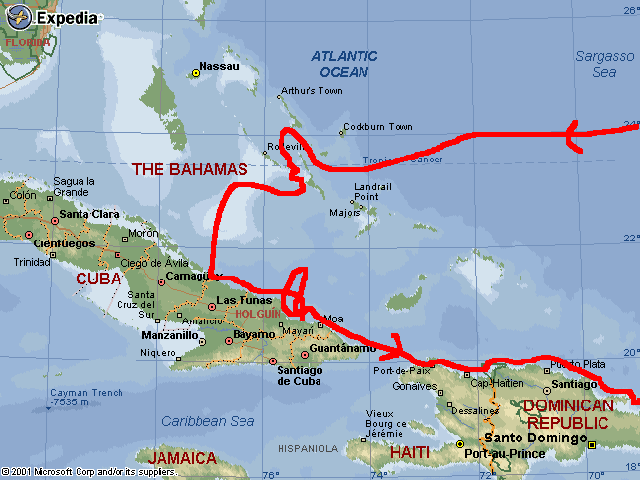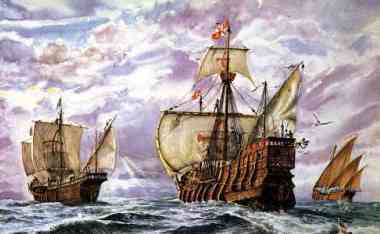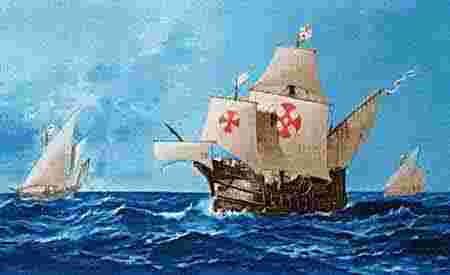Cristóbal Colón
First Voyage 1492 - 1493
|
|
| Everybody is familiar with the story of Christopher Columbus's struggle to get support from the Kings and Queens of Europe to prove that he could sail west to reach the riches of the Far East. I well not go into that story, since it is not the purpose of these pages. |
|
Colón, set sail from the port of Palos, in southern Spain on August 2,
1492. His squadron consisted of three small ships. The first ship was
owned by Cristóbal Quintero, and was named Pinta.
The second ship was owned by Juan Niño, and was named the Santa
Clara, but became known by its nickname, the Niña.
Both of these ships were caravels, at 60 tones and between 70 to 80 feet
long, and with a crew of between 20 to 30 men. The Flag Ship was the
Santa Maria, had a crew of about 40 men.
This ship was larger than the other two, and it was rounder than the
caravels, with a large hold. This ship was owned by Juan de la Cosa
and displaced about 90 to 100 tons, and was about the same length as the
other two. The crew was composed mostly of sailors from the
area, not criminals, has tradition tells us. The list of the crew of
the three ships, list only 87 name; but, some historians believe that
there may have been up to 120 men. Most of the crew were experienced
Spanish sailors from the vicinity of Palos. Other than Columbus, who was
from Genoa, there was another Genoese, a Venetian and a Calabrian on the
crew. There were also, a couple of Spanish government officials. Since
this was a voyage of exploration, there were no soldiers, priests or
settlers on this voyage.
Colón's crew sighted land on October 12, 1492 in the Bahamas, the exact island is the subject of much debate. He arrived in Cuba on October 28. While sailing on the northern coast of Cuba, the captain of the Pinta, Martin Alonso Pinzón, took off on his own, searching for an island called "Babeque". The natives of the area, had told him that it was a land of many riches and plenty of gold. Columbus continued with his other two ships, and sailed south east and discovered Española on December 5th. While exploring the northern coast of Española, the Santa Maria ran
aground on a reef on Christmas Eva, and sank the next day. With the
remains of the Santa Maria, he built a fort and called it La Navidad.
Since all of his men could not fit on the Niña, he left some at La
Navidad, on January 2nd, of 1493, and continued his explorations along the
coast of Española, headed towards Spain. Farther down the coast he ran
into the Pinta. He hoped to return to Spain hoping to mount another
expedition to rescue the men that he was leavening behind in La Navidad.
|
|
|

Note: The course that is outlined is not the exact course taken by Columbus, but an approximation of it. I just want to give the readers an idea of the general course and the mail islands discovered by Columbus on his first voyage of discovery. |


